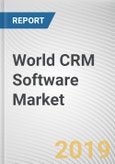CRM software, as a service (SaaS) has a notable and steady growth forecast with increasing awareness towards the importance of CRM for business development. Ability to manage customer interaction at the optimum levels, cost & time effectiveness, focused customer service, capability of handling large businesses & client information are the key factors that drive the growth of the CRM software market. The report analyses growth trends along with a study of critical factors influencing market.
The market is segmented on the basis of application, end-user and geography. The largest markets for CRM software include North America and Western Europe while China and Latin America project a dynamic growth in the CRM software market.
SAP, Oracle Siebel, Salesforce.com, Microsoft Dynamics, NetSuite, IBM are the key players in CRM software market. Workbooks, Nimble, Insightly, Zoho and UserVoice also hold a significant market share in the CRM software. The report comprises key players profiled with their business overview, product portfolios, financials, investments, news and recent developments.
Key Benefits
The report provides a an in-depth analysis of global CRM software markets, with current and future trends to elucidate the imminent investment pockets in the market
Current and future trends are outlined to determine the overall attractiveness and to single out profitable trends to gain a stronger foothold in the market
Quantitative analysis of the current market and estimations through 2013-2020 are provided to showcase the financial attractiveness of the market
Porters Five Forces model is used to analyse the buyer and supplier potential and for highlighting the competitive structure of the market, which would enable market players to devise effective plans and facilitate better decision making
Value chain analysis provides key inputs on the role of all stakeholders in the market
SWOT analysis of key players of market draw out the essential strengths and probable opportunities in the market
CRM SOFTWARE MARKET SEGMENTATION
The market is segmented on the basis of Application, End-user and Geography.
MARKET BY APPLICATION
Customer service
Distribution
Manufacturing
Marketing
Sales
Social networking
Supply chain
Vertical industries
MARKET BY END USER
Small & mid-sized Enterprises
Large Enterprises
MARKET BY GEOGRAPHY
North America
Europe
Asia Pacific
LAMEA
KEY PLAYERS
Salesforce
SAP
Oracle Siebel
Microsoft Dynamics
NetSuite
IBM
Workbooks
Nimble
Insightly
Zoho
UserVoice
Methodology
The analyst offers exhaustive research and analysis based on a wide variety of factual inputs, which largely include interviews with industry participants, reliable statistics, and regional intelligence. The in-house industry experts play an instrumental role in designing analytic tools and models, tailored to the requirements of a particular industry segment. The primary research efforts include reaching out participants through mail, tele-conversations, referrals, professional networks, and face-to-face interactions.
They are also in professional corporate relations with various companies that allow them greater flexibility for reaching out to industry participants and commentators for interviews and discussions.
They also refer to a broad array of industry sources for their secondary research, which typically include; however, not limited to:
- Company SEC filings, annual reports, company websites, broker & financial reports, and investor presentations for competitive scenario and shape of the industry
- Scientific and technical writings for product information and related preemptions
- Regional government and statistical databases for macro analysis
- Authentic news articles and other related releases for market evaluation
- Internal and external proprietary databases, key market indicators, and relevant press releases for market estimates and forecast
Furthermore, the accuracy of the data will be analyzed and validated by conducting additional primaries with various industry experts and KOLs. They also provide robust post-sales support to clients.

LOADING...








